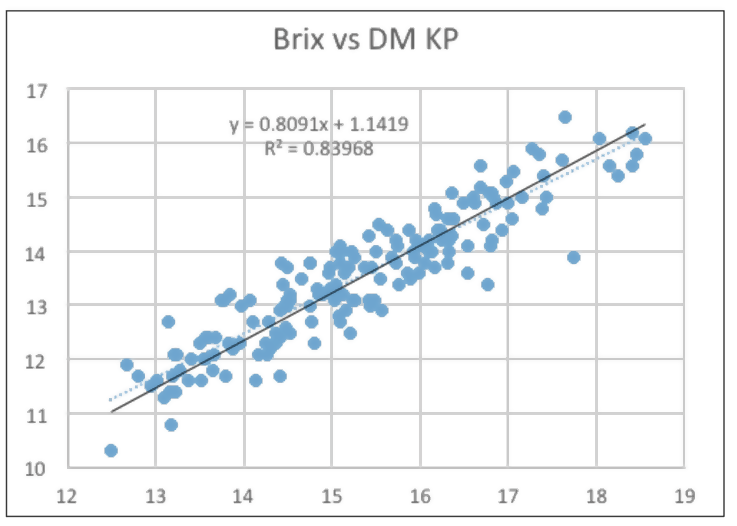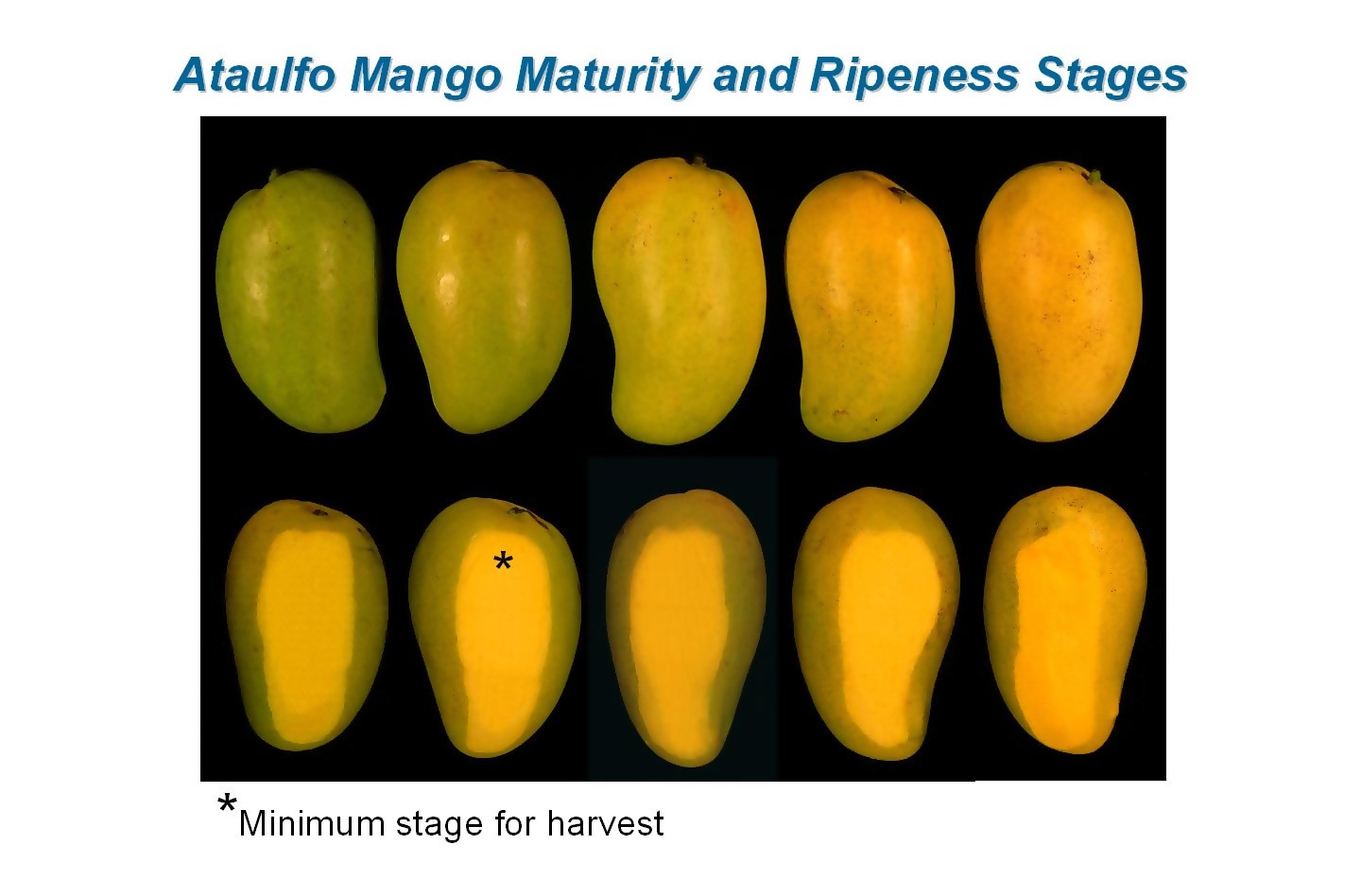October 2, 2019 at 12:43 am | Updated October 2, 2019 at 12:43 am | 6 min read
Dry Matter & Mangos
Mangos are one of the top ten consumed fruits in the world. It is sought for its taste and is well known as the ‘King of Fruits.’ Quality and taste can be guaranteed not only by good cultivation practices, but also by harvesting the fruit at the right time. Good harvest practices can also extend storage and transport time – a must as export of this fruit increases. Dry matter measurement is a proven method to fix harvest time for mangoes.
Dry Matter in the Mango
Dry matter (DM) is used to measure maturity in many fruit commodities. In a nutshell (sometimes literally), dry matter is the solid portion of the fruit that remains after water content is removed. The solids consist of structural and non-structural compounds such as cellulose, proteins, starch, sugars, pigments, and nutrients.
Dry Matter as Maturity Index
The dry matter content will vary over time, during the different stages of fruit development. This variation is the basis for using DM to set harvest time.
Subscribe to the Felix instruments Weekly article series.
By submitting this form, you are consenting to receive marketing emails from: . You can revoke your consent to receive emails at any time by using the SafeUnsubscribe® link, found at the bottom of every email. Emails are serviced by Constant Contact
Most mango varieties are green at maturity, so external colour and firmness alone are not enough to indicate maturity. Luckily, studies have shown that DM content is a reliable index for maturity in mango, too, since the DM percentage increases during maturity at a rate of 0.72% DM/week. So the higher the DM content, the closer the fruit is to maturity. In Australia, DM was found to increase from 11% at the stone hardening stages to 22% at full maturity.
In mangoes, 60-70% of DM is in the pulp, 12-20% in the peel, and 18-20% in the stone. The pulp of well-developed and large fruits contribute to most of its weight. This makes pulp DM a good indicator of maturity.

Figure 1: BRIX increase with DM in the mango variety KP. (Image credit: https://www.industry.mangoes.net.au/resource-collection/2017/3/23/factors-that-influence-dry-matter)
Dry Matter as Quality Index
Mango is a climacteric fruit, so it accumulates most of its carbohydrates as starch while the fruit develops and matures. During the ripening stage, the starch is converted into sugars, making it softer and sweeter.
Since DM measures both starch and sugars, it has proved to be a good indicator of post-harvest quality for mangoes as well. Fruits with more starch will produce more sugars making it appealing to consumers. BRIX, which is used to measure sweetness, has 80% correlation with DM in the case of mangoes (See Figure 1). Therefore, DM at harvest acts as a good indicator of sweetness and eating quality of ripe mangoes.
DM content is best used with internal colour, degrees BRIX, and fruit shape for accurate estimation of harvest time. For example, full shoulders indicate the fruit was harvested when it was mature and will ripen well (See Figure 2).
Ideal DM Content
It is not necessary to leave the mangoes on the trees to reach full maturity to harvest them. Earlier harvest maximises time for transport and storage. So, while mangoes will have 22% DM at full maturity, the ideal harvest time is when a mango has a minimum of 14% of DM. The best DM percentage at harvest, however, differs for varieties and regions.
- In northern Australia, Calypso and KP varieties should have an average of 16.5% DM.
- In southern Australia, Calypso and KP should have more than 16.5% DM.
- Brazilian Ataulfo should have a DM of 14.6-16.4%.
- Brazilian Tommy Atkins should have a DM of 14.0%.
- Mexican Ataulfo should have a DM of 16.9-20.0%.
It should be noted that consumer preference doesn’t always increase with more DM. DM beyond 16.9% and 16.5% for Ataulfo from Brazil and Mexico, respectively, didn’t improve customer satisfaction.
Variations in Dry Matter in Mangoes
The DM in mangoes can be influenced by the following:
- Differences in orchards due to environmental conditions and agricultural practices. Different locations within an orchard or a region have varying environmental conditions, such as temperature, soil fertility, and soil moisture. Agricultural practices will vary from farm to farm.
- Genetic and microsite differences between trees.
- Position of fruits on trees, with sunny sides showing more DM, due to different light levels.
To cover all possible causes of differences in DM, take readings of fruits from several trees and from different parts of an orchard. The average DM is then calculated for the crop.
Measuring DM
DM of developing fruits have to be monitored regularly to find the right harvest time. Therefore, ideally, the method of measurement should be non-destructive, so that there is no loss in crops, as several fruits are tested each time.
Traditional methods of DM estimation—which involve harvesting some fruits, taking samples, and drying—are time-consuming and waste precious fruits. Moreover, these need at least a simple laboratory.
Hence, non-destructive measurements with Near-Infrared (NIR) spectroscopy, which can be incorporated within small hand-held devices is the most popular technology that is used to estimate DM and BRIX. Some examples are two quality meters from Felix Instruments.
- F-751 Mango Quality Meter can take DM and BRIX measurements in a few seconds and is handy on the farms and in the supply chain. The instrument directs light to a mango fruit and measures how it is reflected back to make the calculations. The device interfaces with PCs through WiFi and also has GPS. The data can, therefore, be easily uploaded and used with the free app FruitMaps™ for individual farm plots to track weather and harvest. The model is calibrated for common varieties such as Altaulfo, Calypso, Kent, Keitt, Honey Gold, and Tommy K.
- F-750 Produce Quality Meter is the older model that is suitable for many fruits, including mangoes. It is particularly useful for farmers and horticulturists who grow other types of fruits besides mango, and for supply chains.

Figure 2: Fruit shape and external color (in the top row) and internal color and maturity (bottom row) are shown for Altaulfo at five different stages. (Image credits: http://postharvest.ucdavis.edu/Commodity_Resources/Fact_Sheets/Datastores/Fruit_English/?uid=37&ds=798)
Improving DM Content in Mangoes
Before the fruits are ready for harvest, there are a slew of measures a grower can use to improve fruit DM. These include the following:
- Good agricultural practices—such as proper irrigation, application of nutrient supplements, and pest and disease control—to enhance the health of the crop. Most mango varieties will grow well in different kinds of soils.
- Increasing leaf to fruit ratio to 100:1 improves pulp DM by 6%, so fruits at maturity would have a 20% DM. The final weight of fruits at harvest can also be increased by this method.
- Fruit thinning and water denial two weeks before harvest increases DM without affecting fruit size. DM can be increased to 17.6%, whereas untreated fruits have a DM of 16.5%, and the ripe fruits had Brix of 14.3° against 13.3° in untreated trees.
- Girdling branches two months after flowering increases fruit size.
A Golden Future for Mangoes
Mango is grown in nearly 100 countries, where tropical and sub-tropical conditions exist. In 2017, 50.65 million metric tons of mangoes were grown worldwide. It is the source of livelihoods for millions of people in the tropics. Moreover, global demand is increasing as mango is growing popular in temperate countries as a fruit and also for processed products such as juice, puree, jams, and leather. By using simple tools which fit even small budgets, farmers can improve the quality and quantity of yield to make the most of this cash crop.
—
Vijayalaxmi Kinhal
Science Writer, CID Bio-Science
Ph.D. Ecology and Environmental Science, B.Sc Agriculture
Blog featured image courtesy of Rob and Stephanie Levy.
Sources
Anderson, N.T., Subedi, P.P., & Walsh, K.B. (2017). Manipulation of mango fruit dry matter content to improve eating quality. Scientia Horticulturae 226: 316-321. https://doi.org/10.1016/j.scienta.2017.09.001
Australian Mangoes. (2017, March 23). Factors that influence dry matter. Retrieved from
https://www.industry.mangoes.net.au/resource-collection/2017/3/23/factors-that-influence-dry-matter
Kader, A. A. (1997, February). Recommendations for Maintaining Postharvest Quality. Retrieved from http://postharvest.ucdavis.edu/Commodity_Resources/Fact_Sheets/Datastores/Fruit_English/?uid=37&ds=798
Killadi, B. (2015, Jan1). Retrieved from https://www.researchgate.net/post/Does_Dry_Matter_age_change_during_mango_fruit_maturity_and_ripening
Lechaudel, M., Génard, M., Lescourret, F., Urban, L., & Jannoyer, M. (2002). Leaf-to-fruit ratio affects water and dry-matter content of mango fruit. Journal of Horticultural Science and Biotechnology, 77:773-777. https://doi.org/10.1080/14620316.2002.11511571
Mitra, S.K. (2016). Mango production in the world – present situation and future prospect. Acta Hortic. 1111, 287-296. DOI: 10.17660/ActaHortic.2016.1111.41
Nassur, R.C.M.R., Crisosto, G., de Freitas, S.T., Boas, E.V.B.V, Lima, L.C.O., & Crisosto, C. (2013). Dry Matter as a quality index for Brazilian Mangoes. Retrieved from https://ainfo.cnptia.embrapa.br/digital/bitstream/item/84767/1/Sergio-2013-2.pdf
Owens, G., & Moore, C. Mango Dry Matter Instructions. Retrieved from https://nt.gov.au/__data/assets/pdf_file/0004/267709/mango-dry-matter-instructions-information-sheet.pdf
Science Direct. (2003). Mangoes. Retrieved from https://www.sciencedirect.com/topics/agricultural-and-biological-sciences/mangoes
Statista. (2017). Mango* production worldwide from 2000 to 2017 (in million metric tons). Retrieved from https://www.statista.com/statistics/577951/world-mango-production/
University of California & University of Florida. Mango Maturity and Ripeness Guide. Retrieved from https://www.mango.org/wp-content/uploads/2017/10/Mango_Maturity_And_Ripeness_Guide.pdf
Walsh, K. (2016, March 6). Dry Matter matters. Retrieved https://www.industry.mangoes.net.au/resource-collection/2016/3/6/dry-matter-matters
Related Products
- F-751 Grape Quality Meter
- Custom Model Building
- F-901 AccuStore
- F-751 Melon Quality Meter
- F-751 Kiwifruit Quality Meter
- F-750 Produce Quality Meter
- F-751 Avocado Quality Meter
- F-751 Mango Quality Meter
- F-900 Portable Ethylene Analyzer
- F-950 Three Gas Analyzer
- F-920 Check It! Gas Analyzer
- F-960 Ripen It! Gas Analyzer
- F-940 Store It! Gas Analyzer
Most Popular Articles
- Spectrophotometry in 2023
- The Importance of Food Quality Testing
- NIR Applications in Agriculture – Everything…
- The 5 Most Important Parameters in Produce Quality Control
- Melon Fruit: Quality, Production & Physiology
- Guide to Fresh Fruit Quality Control
- Fruit Respiration Impact on Fruit Quality
- Liquid Spectrophotometry & Food Industry Applications
- Ethylene (C2H4) – Ripening, Crops & Agriculture
- Active Packaging: What it is and why it’s important






